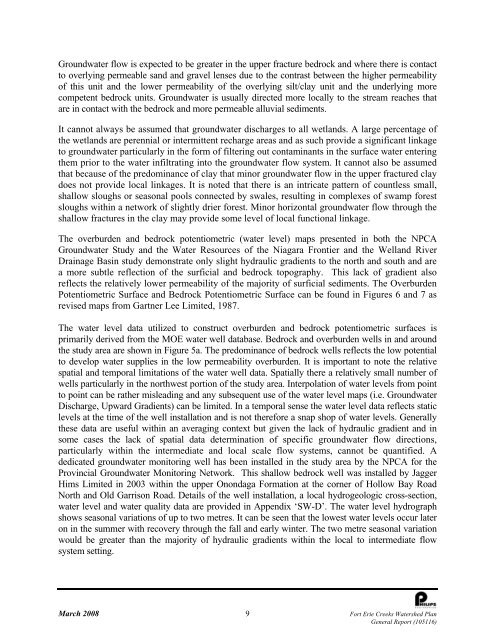Fort Erie Creeks Watershed Plan - Niagara Peninsula Conservation ...
Fort Erie Creeks Watershed Plan - Niagara Peninsula Conservation ...
Fort Erie Creeks Watershed Plan - Niagara Peninsula Conservation ...
Create successful ePaper yourself
Turn your PDF publications into a flip-book with our unique Google optimized e-Paper software.
Groundwater flow is expected to be greater in the upper fracture bedrock and where there is contact<br />
to overlying permeable sand and gravel lenses due to the contrast between the higher permeability<br />
of this unit and the lower permeability of the overlying silt/clay unit and the underlying more<br />
competent bedrock units. Groundwater is usually directed more locally to the stream reaches that<br />
are in contact with the bedrock and more permeable alluvial sediments.<br />
It cannot always be assumed that groundwater discharges to all wetlands. A large percentage of<br />
the wetlands are perennial or intermittent recharge areas and as such provide a significant linkage<br />
to groundwater particularly in the form of filtering out contaminants in the surface water entering<br />
them prior to the water infiltrating into the groundwater flow system. It cannot also be assumed<br />
that because of the predominance of clay that minor groundwater flow in the upper fractured clay<br />
does not provide local linkages. It is noted that there is an intricate pattern of countless small,<br />
shallow sloughs or seasonal pools connected by swales, resulting in complexes of swamp forest<br />
sloughs within a network of slightly drier forest. Minor horizontal groundwater flow through the<br />
shallow fractures in the clay may provide some level of local functional linkage.<br />
The overburden and bedrock potentiometric (water level) maps presented in both the NPCA<br />
Groundwater Study and the Water Resources of the <strong>Niagara</strong> Frontier and the Welland River<br />
Drainage Basin study demonstrate only slight hydraulic gradients to the north and south and are<br />
a more subtle reflection of the surficial and bedrock topography. This lack of gradient also<br />
reflects the relatively lower permeability of the majority of surficial sediments. The Overburden<br />
Potentiometric Surface and Bedrock Potentiometric Surface can be found in Figures 6 and 7 as<br />
revised maps from Gartner Lee Limited, 1987.<br />
The water level data utilized to construct overburden and bedrock potentiometric surfaces is<br />
primarily derived from the MOE water well database. Bedrock and overburden wells in and around<br />
the study area are shown in Figure 5a. The predominance of bedrock wells reflects the low potential<br />
to develop water supplies in the low permeability overburden. It is important to note the relative<br />
spatial and temporal limitations of the water well data. Spatially there a relatively small number of<br />
wells particularly in the northwest portion of the study area. Interpolation of water levels from point<br />
to point can be rather misleading and any subsequent use of the water level maps (i.e. Groundwater<br />
Discharge, Upward Gradients) can be limited. In a temporal sense the water level data reflects static<br />
levels at the time of the well installation and is not therefore a snap shop of water levels. Generally<br />
these data are useful within an averaging context but given the lack of hydraulic gradient and in<br />
some cases the lack of spatial data determination of specific groundwater flow directions,<br />
particularly within the intermediate and local scale flow systems, cannot be quantified. A<br />
dedicated groundwater monitoring well has been installed in the study area by the NPCA for the<br />
Provincial Groundwater Monitoring Network. This shallow bedrock well was installed by Jagger<br />
Hims Limited in 2003 within the upper Onondaga Formation at the corner of Hollow Bay Road<br />
North and Old Garrison Road. Details of the well installation, a local hydrogeologic cross-section,<br />
water level and water quality data are provided in Appendix ‘SW-D’. The water level hydrograph<br />
shows seasonal variations of up to two metres. It can be seen that the lowest water levels occur later<br />
on in the summer with recovery through the fall and early winter. The two metre seasonal variation<br />
would be greater than the majority of hydraulic gradients within the local to intermediate flow<br />
system setting.<br />
March 2008 9 <strong>Fort</strong> <strong>Erie</strong> <strong>Creeks</strong> <strong>Watershed</strong> <strong>Plan</strong><br />
General Report (105116)
















